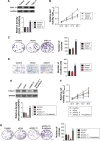Down-regulation of CXCL11 inhibits colorectal cancer cell growth and epithelial-mesenchymal transition
- PMID: 30425523
- PMCID: PMC6205823
- DOI: 10.2147/OTT.S167872
Down-regulation of CXCL11 inhibits colorectal cancer cell growth and epithelial-mesenchymal transition
Abstract
Background: The poor prognosis of colorectal cancer (CRC) largely results from local invasion and tumor metastases. Epithelial-mesenchymal transition (EMT) is a key step in the progression of solid tumors and plays a vital role in tumor metastasis. Recent studies demonstrate that C-X-C motif chemokine 11 (CXCL11) is involved in various cancers' progression. However, its biological activity in CRC needs deeper exploration.
Methods: The level of CXCL11 in CRC tissues and cell lines was determined using the quantitative real-time PCR (qRT-PCR) assay. The MTT, colony formation, wound healing and Transwell invasion assays were applied to assess the role of CXCL11 in CRC cell growth, migration and invasion, in vitro, respectively. A xenograft model was constructed to analyze the function of CXCL11 in CRC cell growth in vivo.
Results: CXCL11 was over-expressed in CRC tissues and cell lines. Repression of CXCL11 significantly inhibited CRC cell migration, invasion and EMT in vitro. In addition, down-regulation of CXCL11 reduced CRC cell growth and metastasis in vivo. Finally, we revealed that repression of CXCL11 inhibited the metastatic ability of CRC cell in a N-cadherin dependent manner.
Conclusion: In summary, this study explicates the oncogenic activities of CXCL11 in CRC cell growth and metastasis.
Keywords: CXCL11; EMT; colon cancer; invasion; migration.
Conflict of interest statement
Disclosure The authors report no conflicts of interest in this work.
Figures







Similar articles
-
LncRNA TUG1 promoted KIAA1199 expression via miR-600 to accelerate cell metastasis and epithelial-mesenchymal transition in colorectal cancer.J Exp Clin Cancer Res. 2018 May 18;37(1):106. doi: 10.1186/s13046-018-0771-x. J Exp Clin Cancer Res. 2018. Retraction in: J Exp Clin Cancer Res. 2021 Feb 04;40(1):55. doi: 10.1186/s13046-021-01855-4. PMID: 29776371 Free PMC article. Retracted.
-
Resveratrol suppresses epithelial-to-mesenchymal transition in colorectal cancer through TGF-β1/Smads signaling pathway mediated Snail/E-cadherin expression.BMC Cancer. 2015 Mar 5;15:97. doi: 10.1186/s12885-015-1119-y. BMC Cancer. 2015. PMID: 25884904 Free PMC article.
-
TRPM7 deficiency suppresses cell proliferation, migration, and invasion in human colorectal cancer via regulation of epithelial-mesenchymal transition.Cancer Biomark. 2019;26(4):451-460. doi: 10.3233/CBM-190666. Cancer Biomark. 2019. PMID: 31640089
-
The MiR-495/Annexin A3/P53 Axis Inhibits the Invasion and EMT of Colorectal Cancer Cells.Cell Physiol Biochem. 2017;44(5):1882-1895. doi: 10.1159/000485877. Epub 2017 Dec 8. Cell Physiol Biochem. 2017. PMID: 29224019
-
miR-132 inhibits colorectal cancer invasion and metastasis via directly targeting ZEB2.World J Gastroenterol. 2014 Jun 7;20(21):6515-22. doi: 10.3748/wjg.v20.i21.6515. World J Gastroenterol. 2014. PMID: 24914372 Free PMC article.
Cited by
-
A combination of inhibitors of glycolysis, glutaminolysis and de novo fatty acid synthesis decrease the expression of chemokines in human colon cancer cells.Oncol Lett. 2019 Dec;18(6):6909-6916. doi: 10.3892/ol.2019.11008. Epub 2019 Oct 18. Oncol Lett. 2019. PMID: 31788130 Free PMC article.
-
Identification of Hub Genes Related to Carcinogenesis and Prognosis in Colorectal Cancer Based on Integrated Bioinformatics.Mediators Inflamm. 2020 Apr 9;2020:5934821. doi: 10.1155/2020/5934821. eCollection 2020. Mediators Inflamm. 2020. PMID: 32351322 Free PMC article.
-
miR-1298-5p Influences the Malignancy Phenotypes of Breast Cancer Cells by Inhibiting CXCL11.Cancer Manag Res. 2021 Jan 11;13:133-145. doi: 10.2147/CMAR.S279121. eCollection 2021. Cancer Manag Res. 2021. PMID: 33469358 Free PMC article.
-
Colorectal cancer extracellular acidosis decreases immune cell killing and is partially ameliorated by pH-modulating agents that modify tumor cell cytokine profiles.Am J Cancer Res. 2022 Jan 15;12(1):138-151. eCollection 2022. Am J Cancer Res. 2022. PMID: 35141009 Free PMC article.
-
Construction of a CXC Chemokine-Based Prediction Model for the Prognosis of Colon Cancer.Biomed Res Int. 2020 Mar 30;2020:6107865. doi: 10.1155/2020/6107865. eCollection 2020. Biomed Res Int. 2020. PMID: 32337262 Free PMC article.
References
LinkOut - more resources
Full Text Sources
Research Materials

